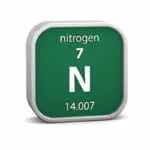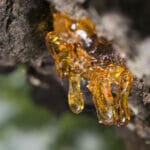Have you ever looked at the loaf of bread on your table and been afraid of it? Have you wondered if it could catch fire or maybe even explode? Probably not. But should you? Again, probably not. But what about the flour used to make that bread? Are the answers to those questions the same or different?

Flour has been around for thousands of years, and wheat flour, corn flour, and rye flour form the foundation of staple foods for cultures worldwide. But does our use of flour put us in danger? Well, not all by itself. What about when you add fire to the mix - is flour flammable? Is flour explosive? Read on to learn more about flour and the unknown dangers it adds to our lives!
Is Flour Flammable?
The short answer is yes. Flour is flammable, it can catch fire, and it has caused explosions in many situations. But, as with most things, there is more to the story.
What Is Flour?
Flour is the powder resulting from grinding grains, usually wheat. Although, mills can also grind it from nuts, roots, beans, and seeds. When talking about grains, we typically refer to the edible seeds harvested from cereal plants.
These seeds have three parts: the bran, the germ, and the endosperm. First, the bran is the protective outer layer of the grain seed. Then the part that grows into a plant is the germ. Finally, the endosperm acts as the food storage for the developing plant.
For grain to become flour, it must go through a milling process, which results in the grain being broken down into tiny particles. In the end, the three main parts of the wheat kernel (the germ, the bran, and the endosperm) are separated and ready for use.
There are many types of flour. White flour (made from the endosperm only), also known as refined or bleached flour, and whole-wheat flour (made by recombining the endosperm with the germ and the bran once the germ stabilizes) are the most widely known.
Other flour variations and types, generally differentiated by gluten levels, include, but are not limited to enriched, cake, pastry, all-purpose, bread, unbleached, self-raising, wheat, rye, corn, corn starch, peanut, potato starch, potato, and rice.
Flour is composed chiefly of starches known as polysaccharides. These are a subset of carbohydrates whose core molecules are bonded by sugar molecules.
So, if you’ve ever put your marshmallow (aka sugar molecules) too close to the campfire, you know where we are headed!
What Is Flour Used For?
Flour is used for all types of cooking and baking, depending on the flour type and desired end product.
A higher protein content flour will be harder and stronger, resulting in crusty or chewy bread. And a lower protein content will make for softer flour, which favors cakes, cookies, and pie crusts.
You can use flour to prepare an endless variety of foods (pizza, pasta, cookies, biscuits, etc.) and for thickening sauces and gravies. You can even use it for making play dough and paper-mâché glue!
Chances are pretty good that you've eaten something with flour at some point in your life and more than likely made something with flour.
Why Is Flour Flammable?
Flour is highly flammable because, as previously mentioned, its main component is starch, a carbohydrate that can catch fire - think back to those marshmallows. Now, if the flour stayed in a solid piece like the loaf of bread on your table, it wouldn’t be a fire hazard and would probably not burn much.
However, flour particles are fine dust, and dust and powders tend to catch fire when floating freely in the air (aka oxygen) in the presence of heat. This property is what makes flour combustible dust.
Since the dust particles are suspended and separated in air, when compared to their solid form, they take up more surface area, allowing the flour dust to absorb and transfer more heat, burning more quickly.
So, particularly in a kitchen or any similar location with an ignition source close by, since flour is flammable, you should store any in tightly packed, airtight containers to reduce the chance of a large number of dust particles getting into the air.
Is Flour Explosive?
Not only is flour flammable, but it can also explode. A flour dust explosion or combustible dust explosion is caused by those tiny suspended flour particles catching fire in the presence of heat, instantly igniting other particles nearby, and then expanding rapidly through the dust cloud with incredible force, resulting in an explosion.
What Other Dust Explosion Hazards Exist?
Other kitchen items besides flour are flammable or explosive. For example, almost any carbohydrate dust like powdered sugar, non-dairy creamer, pudding mix, powdered milk, cornstarch, and cocoa will explode if ignited. And this is just a small number of other items - the list is extensive!
Outside the home, things like grain, wood, coal, and metals could have the potential for a dust explosion. Like flour, metals, for example, may not typically be combustible when in a more compact or solid form, but they can burn or explode if the particles are the right size and in the right concentration while mixed with oxygen and a heat source.

How Flammable Is Flour And Flour Dust?
In the home, the risk of flour dust starting a fire or causing a flour explosion is minimal because the quantity of flour used at any one time is typically small. In addition, the way it is used, like being mixed with water, doesn’t lead to large clouds of dust particles.
However, the risk of an explosion is much higher in industrial settings, like grain mills and processing plants. This is because these facilities regularly handle a substantial amount of flour and are typically large buildings with spaces that can easily let the powder separate and form sizable dust clouds.
In addition to the dust created during general processing, large bags can burst while being moved around the mill, the powder can pile up in storage bins and silos, or there could be dust accumulation in rail cars.
These settings and situations typically pose the most significant explosion hazard since any ignition source, like a spark or wayward flame, in these environments could be a trigger.
And if a fire starts in one of these places, not only is an explosion likely directly in the area with the dust accumulation, but given the size of the mills and proximity to other buildings, the risk of a secondary explosion also exists.
Unfortunately, grain dust explosions have occurred at mills worldwide, and when you hear about them, they usually involve devastation and loss of life. Luckily, the severity of those explosions has lessened over time as more safety measures have been implemented.
How To Prevent Flour Dust Explosions
Whether at home or in an industrial setting, the approach to safety is the same - keep the flour as confined and tightly packed as possible to reduce or eliminate the possibility of dust clouds forming and keep flour away from heat and flame sources.
You don’t have to fear using flour in your home’s kitchen since the possibility of fire is minimal, given the quantity of flour involved and the lack of a confined space. And any fires that happen would most likely be minor and easy to suppress with a fire extinguisher or fire blanket.
Just remember - if there is no dust cloud, there is no explosion!








